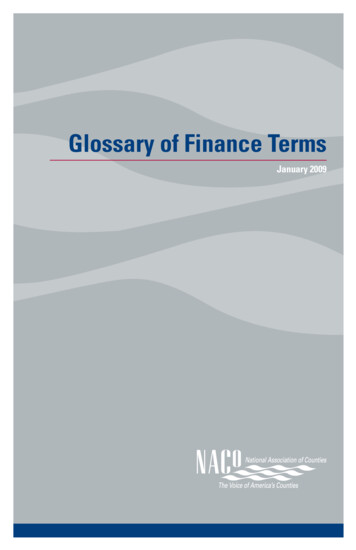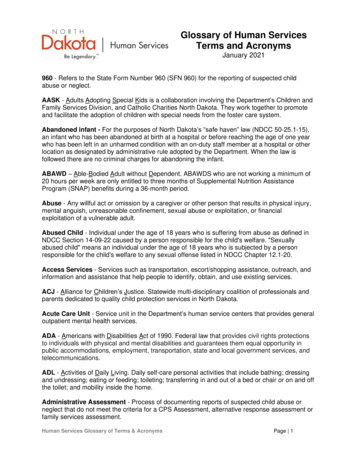
Transcription
Glossary of Finance TermsJanuary 2009
Glossary of Public Finance TermsGlossary ofPublic FinanceTerms1Updated byJacqueline J. ByersDirector of Researchand OutreachJanuary 2009About NACo – The Voice of America’s CountiesThe National Association of Counties (NACo) is the only national organization thatrepresents county governments in the United States. Founded in 1935, NACo providesessential services to the nation’s 3,068 counties. NACo advances issues with a unifiedvoice before the federal government, improves the public’s understanding of county government, assists counties in finding and sharing innovative solutions through educationand research, and provides value-added services to save counties and taxpayers money.For more information about NACo, visit www.naco.org.
Financing county government programs and services hasalways been a critical function. However, it is becomingincreasingly significant as both the federal government andstates continue to devolve program responsibilities to countygovernments. NACo is committed to helping counties meetthese challenges.This publication, A Glossary of Public Finance Terms forCounty Officials, should become a resource for all countyleaders. It is a comprehensive glossary of over 240 publicfinance terms every elected official should know. We would likethis publication to be not only a glossary, but also a guide forlocal officials to discover and investigate new financing options.We know that county officials will find this publicationuseful in making informed decisions about county governmentfinances.Larry E. NaakeNACo Executive Director
Glossary of Public Finance TermsAAbatements: A term referring to the refund of previously paid property taxes due to the over-valuation of property.Accrual Basis: The basis of accounting under which revenues are recorded when earned and expenditures are recorded as soon as theyresult in liabilities for benefits received.Accrued Interest: Interest accrued on a bond or other fixed incomesecurity since the last interest payment was made. At the time of asale, the buyer of a bond pays the market price plus accrued interest to the seller. Exceptions are bonds that are in default (termedto be ‘trading flat’). Accrued interest is calculated by multiplyingthe coupon rate by the number of days that have elapsed since thelast payment.Adjusted Gross Income (AGI): Total income from all taxable sources less certain expenses incurred in earning that income.Adopted Budget: Refers to the budget amounts as originally approvedby the county’s legislative body.Ad Valorem Tax: A tax based on the value of taxable property. Advalorem is a Latin term meaning “according to value.”Advance Refunding Bonds: Bonds that are issued to refund an outstanding issue before its natural maturity date. Proceeds from theadvance refunding bonds are invested in U.S. Treasury Bonds orother authorized securities, and are used to pay interest and principal on the bonds that were refunded until they are called or reachmaturity.Alternative Minimum Tax: The tax liability calculated by an alternative set of rules designed to force individuals with high levels ofpreference income to incur at least some tax liability.Amended Budget: A budget that includes changes to the adoptedbudget that have been approved by the county’s legislative body.Also referred to as a revised budget.Amortization: The gradual reduction of bonded debt according to aspecific schedule of payment times and amounts.Appropriation: Authority to spend money within a specified dollarlimit for an approved program or project during the fiscal year.3
4National Association of CountiesArbitrage: With respect to the issuance of municipal bonds, arbitrageusually refers to the difference between the interest paid on thebonds issued and the interested earned by investing the bond proceeds in other securities. Arbitrage profits are permitted on bondproceeds for various temporary periods after issuance of municipalbonds. Internal Revenue Service regulations govern arbitrage ofmunicipal bond proceeds.Assessable Base: The value of all real and personal property in thecounty used as a basis for levying taxes. Tax-exempt property isexcluded from the assessable base.Assessed Value: The value a jurisdiction assigns to a property for taxpurposes. Assessed value is less than market value.Assessment Ratio: The ratio of a property’s assessed value to its market value.Assessment Bonds: Bonds secured by a direct fixed lien(s) on assessedproperties to finance the acquisition and construction of local improvements.Audit: An examination of evidence, including records, facilities, inventories, systems, etc., to discover or verify desired information.A written report of findings will normally result, and findings willgenerally be based on investigation of a sample of agency operations.Average Life: The average length of time that an issue of bonds is expected to be outstanding. The total number of bond years dividedby the total number of bonds.BBalance Sheet: A statement of the financial position of an entity thatpresents the value of its assets, liabilities, and equities on a specified date.Balloon Maturity: A bond issue with substantially more late maturities than early maturities. Some or all of the late maturities areoften callable to allow for early redemption.Bank Qualification: Up to 10,000,000 in public purpose bonds ofa given issuer may be designated as “qualified tax exempt obliga-
Glossary of Public Finance Termstions” pursuant to Section 265(b) of the Internal Revenue Codein any calendar year. Such bonds are more marketable, and thusprice better in the market, because certain financial institutionsthat purchase the bonds are given more favorable tax treatment onmoney they are deemed to have borrowed to carry the bond.Bid: A formal, binding document used to obtain pricing from vendorsfor a specific period of time. It contains complete specifications ofthe goods or services requested by the county. A bid also includespayment terms, delivery requirements, and other conditions thatdefine the scope of the purchase. Bids are used to establish countycontracts for products or services or for one-time purchases of highdollar items (usually over 1,000).Block Grant: A type of grant given primarily to a general-purposegovernment unit in accordance with a statutory formula. Suchgrants can be used for a variety of activities within a broad functional area.Bond: A bond is a written promise to repay borrowed money on adefinite schedule and usually at a fixed rate of interest for the life ofthe bond. State and local governments repay this debt with taxes,fees, or other sources of governmental revenue. Since most governmental bonds are tax-exempt, bondholders are generally willing toaccept a correspondingly lower rate of return on their investmentthan they would expect on a comparable commercial bond. Bondfinancing, therefore, can often provide state and local governments with low-interest capital. Some state and local governmentsare required by law to seek voter approval, for certain types of bondissues.Bond Anticipation Notes: Interim short-term tax-exempt obligationsused to provide funds for construction or completion of an enterprise. The proceeds of a future bond issue are pledged to pay thenote at maturity. Upon completion and final costing of the project, a tax-exempt bond issue provides permanent financing, andthe bond anticipation notes are retired.Bond Insurance: Insurance that guarantees the timely payment ofprincipal and interest to bondholders.Bond Rating: Bond ratings are assessments made by investor advisory companies, also known as rating agencies, of credit quality or,conversely, the risk that the borrowing government will not makescheduled payments of principal and interest. Rating agencies basetheir ratings on a number of economic, debt, financial, and gov-5
6National Association of Countiesernmental factors. These ratings significantly influence the interest rate that a borrowing government must pay on its bond issues.Budget: A financial plan, including proposed expenditures and estimated revenues, for a period in the future, usually for one year.CCallable Bonds: Bonds that are redeemable by the issuer prior to thespecified maturity date at the specified price at or above par.Capital Budget: The annual request for capital project appropriations.Project appropriations are normally only for that amount necessary to enable the implementation of the first year of the capitalprogram expenditure plan. However, if contracted work is scheduled that will extend beyond the upcoming fiscal year, the entirecontract appropriation is required, even if the work and expenditures will be spread over two or more fiscal years.Capital Gain: An increase in the value of an asset.Capitalization: The process by which a stream of tax liabilities becomes incorporated into the price of an asset.Capital Improvements Program (CIP): The comprehensive presentation of capital project expenditure estimates; funding requirements;capital budget requests; and program data for the construction ofall public buildings, roads, and other facilities planned by countyagencies usually over a five or six-year period. The CIP constitutesboth a fiscal plan for proposed project expenditures and funding,and includes the annual capital budget for appropriations to fundproject activity during the first fiscal year of the plan. .Capital Lease: A long-term rental agreement that transfers substantial rights and obligations for the use of an asset to the lessee and,generally, ownership at the end of the lease. Similar to an installment purchase, a Capital Lease may also represent the purchase ofa fixed asset and the incidence of a long-term liability.Capital Project: Governmental effort involving expenditures andfunding for the creation, expansion, renovation, or replacement ofpermanent facilities and other public assets having relatively longlife. Expenditures within capital projects may include costs for theplanning, design, and construction management; land; site im-
Glossary of Public Finance Termsprovements; utilities; construction; and the initial furnishings andequipment required to make a facility operational.Capitalized Interest: A portion of bond proceeds that are set aside topay interest on the bonds until the projects funded by those bondsare built, operating, and capable of generating revenues for makingdebt service payments.Carryover: The process in which, at the end of one fiscal year, appropriation authority for previously-approved encumbrances and unexpended grant and capital funds are carried forward to the nextfiscal year.Cash Management: An effort to manage cash flows in such a waythat interest and penalties paid are minimized and interest earnedis maximized.Categorical Grants: A type of grant that may only be used for a specific program that is usually limited to a narrowly defined activity.Categorical grants consist of formula, . project, and formula-projectgrants.Certificate of Participation (COP): A form of lease obligation inwhich the county enters into an agreement to pay a fixed amountannually to a third party, usually a nonprofit agency or a privateleasing company. Otherwise, they do what municipal bonds do:They raise money to acquire equipment or construct a facility.According to municipal finance experts, almost anything can beengineered for lease. COPs are similar to bonds, but are not legally classified as such, meaning that state and local governmentscan issue them without voter approval and without affecting theiroverall bonding capacity.Circuit Breaker: A type of residential property tax relief in whichbenefits depend on income and/or wealth and property tax payments. A circuit breaker usually takes one of two forms. Under thethreshold approach, an “acceptable” tax burden is defined as somefixed percentage of household income (different percentages maybe set for different income levels), and any tax above this portionof income is “excessive” and qualifies for relief. The portion of income that is deemed an acceptable tax burden is the thresholdlevel. Under the sliding scale approach, no threshold is defined.Rather, a fixed percentage of the property tax is rebated for eacheligible taxpayer within an income class. The rebate percentagedeclines as income increases.7
8National Association of CountiesCollective Bargaining Agreement: A legal contract between thecounty government or an agency as employer and a certified representative of a recognized bargaining unit for specific terms andconditions of employment; e.g., hours, working conditions, salaries,or employee benefits.Community Development Block Grant (CDBG): Annual fundingfrom the Federal Government (Department of Housing and UrbanDevelopment) for use in capital projects or operating programs designed to stimulate neighborhood or business area revitalization,housing rehabilitation, and activities on behalf of older and lowerincome areas of the countCompensation: Payment made to employees in return for servicesperformed. Total compensation includes salaries, wages, employeebenefits (Social Security, employer -paid insurance premiums, disability coverage, and retirement contributions), and other forms ofremuneration when these have a stated value.Commercial Paper: A form of short-term tax-exempt debt issued bystate and local governments that matures within a short period(less than 365 days) from the date of Issue.Competitive Underwriting: A sale of municipal securities by an issuer to the underwriter offering the best bid (lowest net or trueinterest cost) in open competitive bidding. Contrasts with negotiated underwriting.Constant Yield Tax Rate: A rate which, when applied to the comingyear’s assessable base, exclusive of the estimated assessed value ofproperty appearing on the tax rolls for the first time (new construction), will produce tax revenue equal to that produced in thecurrent tax year.Construction Fund: A special fund, often held by the trustee or otherfiduciary, into which the net proceeds of an issue are deposited andare to be used to pay project costs. The construction fund is oftenpledged for the payment of the securities, pending its use for thepurpose of paying the project costs.Continuing Disclosure: The requirement that certain issuers of municipal obligations file annual reports concerning financial andoperating data presented in an official statement.Cost-Benefit Analysis: An analytical technique that compares thecosts and benefits of proposed programs or policy actions.
Glossary of Public Finance TermsCost Center: Expenditure categories within a program area that relate to specific organizational goals or objectives. Each cost centermay consist of an entire agency or a part of an agency.Cost of Issuance: Expenses paid by the issuer directly related to theauthorization, sale, and issuance of bonds. These costs may includelegal fees, trustee’s fees, printing costs, bond discounts, cost ofcredit ratings, fees and charges for execution, as well as filing andrecording fees.Coupon: Detachable portions of a bond presented by its holder tobond issuer’s paying agent to document interest due. The couponrate is the rate of interest on face value that the coupons reflect.Current Revenue: A funding source for the Capital Budget that isprovided for annually within the Operating Budget from general,special, or enterprise revenues. Current revenues are used for funding project appropriations not eligible for debt financing or to substitute for debt-eligible costs.DDated Date: The date of a bond issue from which the bondholder isentitled to receive interest even though the bonds may actually bedelivered at some other date.Debt: The total amount owed at a given point in time; the sum of allpast deficits.Debt Limit: The statutory or constitutional maximum debt that anissuer can legally incur.Debt Service: The annual payment of principal, interest, and issuecosts of bonded indebtedness. Debt service is presented both interms of specific bond allocations by category, fund and by sourcesof revenues used.Debt Service Fund: A fund used to record fiscal activities related tothe payment of principal, interest, and overhead costs of general obligation debt, capital leases, and equipment purchase agreements.Default: Failure by the issuer to pay the principal or interest due on abond, or failure to fulfill other agreed upon legal and contractualobligations.9
10National Association of CountiesDeficit: The amount by which expenditures exceed revenues duringan accounting period.Depreciation: The decline of the useful life of a fixed asset over adetermined period of time attributable to wear and tear, deterioration, action of the physical elements, inadequacy, and obsolescence. Also, the portion of the cost of a fixed asset charged as anexpense during a particular period.Derivatives: A complex investment that is largely unregulated, especially when compared with stocks and bonds. They are securitieswhose value is derived from some other variable, such as interest rates or foreign currencies, and can be used to reduce risk orincrease returns. Derivatives are rarely used and significantly restricted in most states.Development District: A special taxing district created to financethe costs of infrastructure improvements necessary for the development or redevelopment of land of high priority to the county.These districts are often designated for areas that the county’slong-range master plan recommends significant development.Development Impact Fee: A payment of money imposed upon newproperty developments as a condition of approval from the county.Development impact fees pay for a proportionate share of the costof improvements needed to serve new growth and development.Disbursement: Expenditure or a transfer of funds to another accounting entity within the county’s financial system. Total disbursements equal the sum of expenditures and transfers.Double-barreled Bond: A bond secured by the pledge of more thanone source of repayment, often project revenue and taxing power.EEarned Income Tax Credit: A tax credit for low-income individuals.Electronic Commerce: It is the use of computer networks to facilitate transactions involving the production, distribution, and saleand delivery of goods and services in the marketplace. A paperlessexchange of business information using the Internet, E-mail, electronic bulletin boards, and similar technologies.
Glossary of Public Finance TermsEmployee Benefits: For budgeting purposes, employee (fringe) benefits are payments by the employer for Social Security, retirement,and group insurance.Encumbrance: An accounting commitment that reserves appropriated funds for a future expenditure. The total of all expenditures andencumbrances for a department or agency in a fiscal year, or for acapital project, may not exceed its total appropriation. The commitments relate to unperformed contracts for goods or services.Enterprise Fund: A fund established to finance and account for theacquisition, operation, and maintenance of governmental facilitiesand services that are wholly or partially supported by user charges/fees. Examples include liquor control and parking facilities.Excise Tax: A tax levied on the purchase of a particular commodity.Expendable Trust Funds: Accounting entities for assets the countydoes not own but must use for certain purposes, such as escrow deposits held by the county and retiree group insurance reserves.Expenditure: A decrease in the net financial resources of the countygenerally due to the purchase of goods and services, the paymentof salaries and benefits, and the payment of debt service.Expenses: Charges incurred, whether paid or unpaid, by the countyfor operation, maintenance, interest, and other charges that arepresumed to benefit the current fiscal period.FFee: A charge for service to the user or beneficiary of the service.Fiduciary Funds: Assets held by the county in a trustee capacity oras an agent for individual private organizations, other governmental units, and/or other funds. These can include expendable trustfunds, agency funds, pension trust funds, and nonexpendable trustfunds.Fines: Charges levied for violations of laws, regulations, or codes.Fiscal Policy: The County’s policies with respect to revenues, expenditures, and debt management as these relate to county services,programs, and capital investments. A fiscal policy provides a set11
12National Association of Countiesof principles for the planning and programming of budgets, uses ofrevenues, and financial management.Fiscal Plan: Estimates of revenues, based on recommended tax policyand moderate economic assumptions, and projections of currentlyknown or recommended commitments for future uses of resources.Fiscal Projections: Estimates of revenues and projections of possibleexpenditures for the functions of government, including analysisof the impact of tax and expenditure patterns on public programsand the economy of the county.Fiscal Year (FY): A twelve-month period designated as the operatingyear for accounting and budgeting purposes in a county. A fiscalyear can start on different dates depending upon the county, including January 1st and July 1st.Fixed Assets: Assets of a long-term character that are intended tocontinue to be held or used. Examples of fixed assets include itemssuch as land, buildings, machinery, furniture, and other equipment.Flat Tax: A tax for which the marginal tax rate is constant throughout the entire range of Incomes.Formula Grants: A type of grant that allocates federal funds to statesor their subdivisions in accordance with a distribution formula prescribed by law or administrative regulation.Franchise Fee: A fee levied on a corporation in return for authorizedconduct of business on or use of public property, or as otherwiseprovided for by county law.Full-Time Equivalent (FTE): A standardized unit for measurementof government personnel effort and costs. A position authorizedfor 40 hours per week is reflected in the budget as one authorizedposition with a full-time equivalency of one (1/1.0 FTE).Fund: An accounting devise established to control the receipt anddisbursement of revenues for the purpose of implementing specificactivities or achieving certain objectives in accordance with special regulations, restrictions, or limitations, and constituting anindependent fiscal and accounting entity.Fund Balance: Undesignated reserves in a fund, the amount by whichresources exceed the obligations of the fund. Fund balance may bemeasured as a percentage of revenues or expenditures.
Glossary of Public Finance TermsGGeneral Fund: The principal operating fund for a county government. The General Fund is used to account for all financial resources except those required by law, county policy, and generallyaccepted accounting principles that are to be accounted for in another fund.General Obligation (G.O.) Bond: A bond secured by the pledge ofthe county’s full faith, credit, and taxing power. Many state and/or county laws require voter approval of G.O. Bonds. These bondsare regarded as safer than bonds backed by a single revenue source,and generally command lower interest rates and lower reserve fundrequirements.General Revenue: Money received that may be used to fund generalcounty expenditures such as education, public safety, public welfare, debt service, etc. Funds received that are restricted as to useare not general revenues and are accounted for in other funds.General Sales Tax: A tax levied at the same rate on the purchase ofall commodities.General Wage Adjustment (GWA): An increase in salaries otherthan seniority-based merit increases (increments). GWA is also referred to as a Cost-of-Living Adjustment (COLA).Grant: A payment from one level of government to another or from aprivate organization to a government. Grants are made for specified purposes and must be spent only for that purpose.Gross Budget: The total cost of a department’s operation (not appropriation), including those expenditures that are charged to (andpaid by) other funds, departments, agencies, or CIP projects.Gross Debt: The sum total of an issuer’s debt obligations.Gross Estate: All property owned by the decedent at the time ofdeath.Gross Spread: The dollar difference between the amount the issuerreceives for its securities and the amount that the investors pay forthose securities; the gross revenue accruing to the underwriters ofa security prior to any costs or expenses.13
14National Association of CountiesHHomestead: A homestead can be a separate structure, condominium,or a mobile home located on owned or leased land as long as theindividual living in the home owns it.Homestead Exemption: Homestead exemptions remove part of ahome’s value from taxation in order to lower property taxes. Forexample, if your home is appraised at 50,000, and you qualify fora 15,000 exemption, you will pay taxes on the home as if it wasworth only 35,000.Horizontal Equity: In terms of taxation, people in equal positionsshould be treated equally.IImpact Fees: An impact fee is a one-time charge that requires newdevelopment to pay a proportionate share of the revenue neededfor construction or expansion of capital facilities to serve the newdevelopment. Impact Fees can be collected for many things, including roads, schools, and water system improvements.Incremental Funding: The provision of budgetary resources for aprogram or project based on obligations estimated to be incurredwithin a fiscal year when such budgetary resources will cover onlya portion of the obligations to be incurred in completing the program or project as programmed.Individual Retirement Account (IRA): For qualified individuals, asavings account in which the contributions are tax deductible andthe interest accrues tax free, provided the funds are held until retirement. On withdrawal, both contributions and accrued interestare subject to tax.Inheritance Tax: Tax levied on an individual receiving an inheritance.Indirect Costs: That component of the total cost for a service thatis provided by and budgeted within another agency in the county(e.g., legal support, personnel).
Glossary of Public Finance TermsInterest Rate: The percentage rate at which a bond bears interest.Interfund Transfer: A transfer of resources from one fund to anotheras required by law or appropriation. The funds are considered revenues of the source fund, not the receiving fund.Intergovernmental Revenue: Funds received from Federal, state, andother local government sources in the form of grants, shared taxes,reimbursements, and payments in lieu of taxes.Internal Service Funds: Separate financial accounts used to recordtransactions (primarily goods and services) provided by one department to other departments of the county government on acost-reimbursable basis. Examples are: motor pool, central duplicating, risk management, and printing and mail.Issuer: A government, political subdivision, agency, or authority thatborrows money through the sale of bonds or notes.LLapse: The reduction of gross personnel costs by an amount believedunnecessary because of turnover, vacancies, and normal delays infilling positions. The amount of lapse will differ among departments, and from year to year.Lease-Purchase Agreement: A contractual agreement which istermed “lease,” but is in substance a purchase contract with payments made over time.Lease-Purchase Financing: A long-term lease sold publicly to financecapital equipment or real property acquisitions. A Certificate ofParticipation is one example.Lease Revenue Bond: A bond secured by a lease agreement and rental payments from one public agency (lessee) to another (lessor).Lease payments are typically made from revenue sources includinggeneral fund, enterprise fund or user fees. The lessor and issuer ofthe bonds may be a city, county, non-profit corporation, redevelopment agency, joint powers authority, parking authority, etc. Thetitle reverts to lessee after bonds are retired.Level of Service: The existing or current services, programs, and facilities provided by a government to its citizens. The level of ser-15
16National Association of Countiesvice may increase, decrease, or remain the same depending uponneeds, alternatives, and available resources.Licenses and Permits: Documents issued by the county in order toregulate various kinds of businesses and other activities. Inspectionmay accompany the issuance of a license or permit, as in the caseof food vending licenses or building permits. In most instances, afee is charged in conjunction with the issuance of a license or permit, generally to cover all or part of the related cost.Limited-liability Bond: A bond that does not pledge the full-faithcredit of the jurisdiction but does usually dedicate a specific revenue source for repayment.Line Item: A specific expenditure category within an agency budget,e.g., rent, travel, motor pool services, postage, or printing.MMaster Lease: A securitized package of leases designed to reduce interest rates compared to standard commercial leases.Means-Tested: A spending program whose benefits flow only to thosewhose financial resources fall below a certain level.Millage: A rate of taxation expressed in mils per dollar (0.01 %), normally in property taxation.Minibonds: County bonds, usually general obligation bonds, issued insmall denominations so that they are affordable to a wider segmentof the population.Mission: The desirable end result of any activity. Missions are generally broad and long range in nature compared to goals, which aremore specific and immediate. An example of a mission is: “to provide safe, reliable, and cost-efficient public transportation to theresidents of the county.”Modified Accrual Basis: The basis of accounting under which expenditures other than accrued interest on general long
Assessable Base: The value of all real and personal property in the county used as a basis for levying taxes. Tax-exempt property is excluded from the assessable base. Assessed Value: The value a jurisdiction assigns to a property for tax purposes. Assessed value is less than market value.










